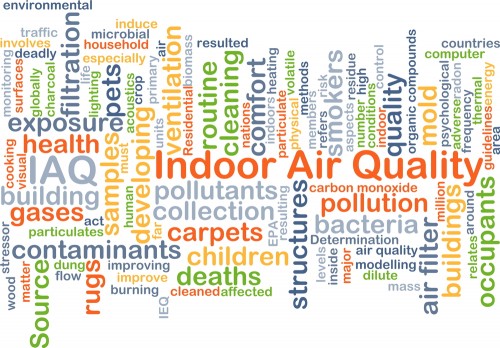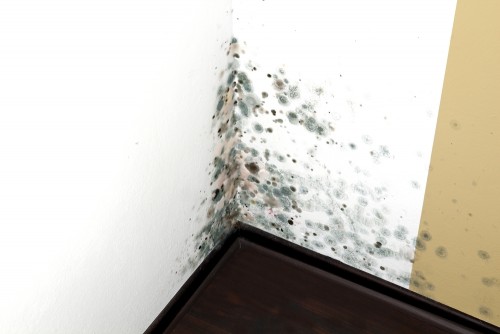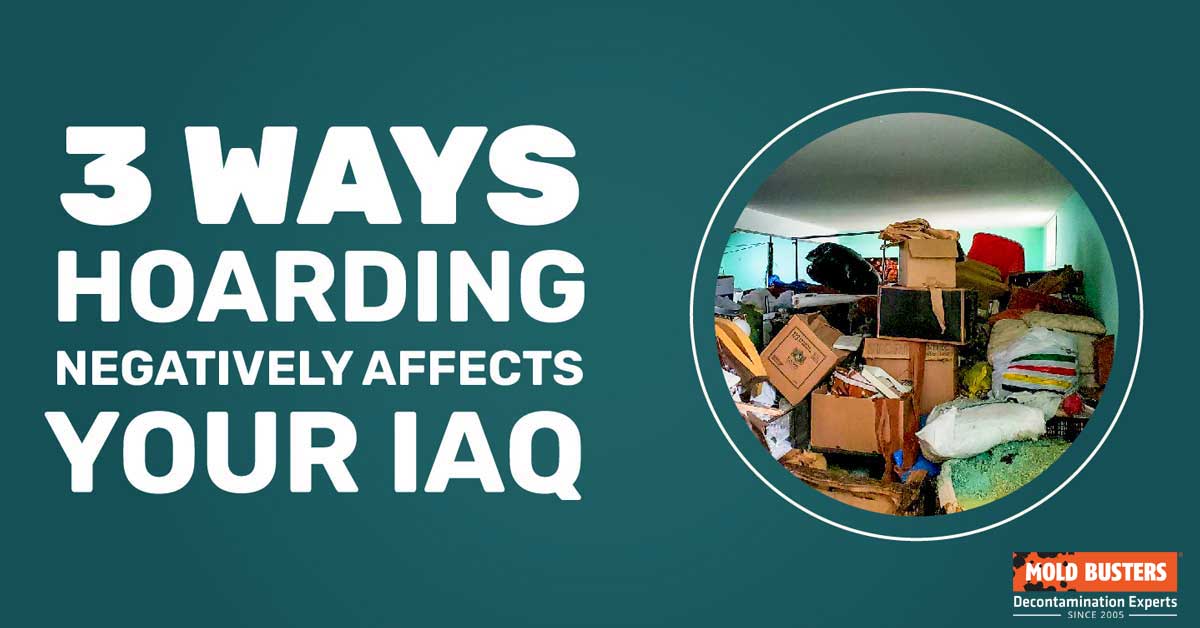Indoor Air Quality: Everything You Need to Know
From noxious fumes to mold spores and hidden asbestos in the attic, there are many ways your air quality can severely threaten your wellness over time. Fortunately, our team of air quality testing professionals knows how to quickly identify and address problem areas. Let’s take a deeper look at the fundamentals of why air quality control plays such a major role in health and safety assurance.
Because we spend so much time in our homes and our offices, it’s crucial that our indoor air remains clean. Indoor air quality (IAQ) directly affects our health and, in turn, the quality of our lives.
If the air you breathe is being compromised by mold spores, radon and asbestos fibres, among other contaminants, your health and your safety is at risk.
Not only this, but you may also have a serious problem, such as moisture intrusion, in your home that you weren’t even aware of. As such, poor indoor air quality must be detected and dealt with promptly.
If you live in the Ottawa or Montreal area and suspect an air quality problem, call the certified inspectors at Mold Busters for immediate help.
Indoor air quality facts in Canada
When we think of poor air quality, we often think of the outdoors, polluted by smog, car exhaust and toxic emissions that are the byproduct of industry. Outdoor air pollution is an epidemic that is responsible for millions of deaths worldwide on a yearly basis.
Though it may not be as apparent, indoor air quality is an equally alarming concern from a health and safety standpoint. Canadians spend upwards of 90% of their time indoors. Breathing in contaminated air can lead to a wide range of short-term and long-term health effects, including allergies, asthma and an increased risk of stroke and heart conditions.
Sadly, most people are not even aware of the presence of air contaminants in their home, despite the widespread health effects. Only 1% of Canadian households report poor indoor air quality in their homes, though 5% believe someone in their household has suffered a health problem due to poor indoor air quality and 13% report a presence of mold/mildew in their homes.
In this guide, we are going to explore the questions everyone has been asking about indoor air quality: What are air pollutants? What causes them to amass in the home? What are the health effects of poor indoor air quality? Finally, how can you identify and remediate poor indoor air quality? Let’s get to these questions and more!

Did you know?
Only 6% of tested outdoor air samples didn’t have any presence of mold?! Find out more exciting mold stats and facts inside our mold statistics page.
Who is affected by poor indoor air quality?

Everyone is vulnerable to ill health effects directly attributable to poor indoor air quality, including residents, workers, guests, and pets. However, children, pregnant women, and the elderly are more vulnerable. As you might expect, the more prolonged the exposure and the more severe the presence of pollutants, the more likely a person is to develop ill health effects. People with pre-existing heart conditions such as angina, arrhythmia, or hypertension are more vulnerable, as are those with pre-existing breathing and lung conditions such as asthma or chronic obstructive pulmonary disease (COPD).
What are examples of indoor pollutants?
Broadly put, an indoor air pollutant is any kind of airborne gas, vapour, particulate, microbial contaminant, or substance that can cause negative health effects. Health Canada divides air contaminants into the following categories.
Biological Pollutants
- Mold
- Mildew
- Fungi
- Pollen (aeroallergens)
- Dust Mites
- Bacteria (such as Legionella)
Chemical Pollutants
- Carbon Monoxide (CO)
- Nitrogen Dioxide (NO2)
- Formaldehyde
- Asbestos
- Ozone
- Lead
- Particulate Matter
- Volatile Organic Compounds (VOCs) – any substance that contains carbon and off-gases at room temperature. Household products that may contain VOCs include nail polish, aerosol spray products, and air fresheners.
Radiological Pollutants
Some contaminants on this list are not typically present in the home, but may be emitted under certain circumstances. An example would be leaving the car to idle in the garage, thus emitting toxic CO and other harmful contaminants.

What causes poor indoor air quality?
According to the Canadian Centre for Occupational Health and Safety, the most common sources of indoor air contaminants are as follows:
- Occupants (tobacco smoke, perfume, body odours, CO2)
- Materials (dust, gases, asbestos, fiberglass)
- Cleansers/solvents/pesticides, etc. (VOCs, toxic vapours)
- Off-gas emissions from carpets, furniture, and paints (gases, vapours, odours)
- Carpets and fabrics (dust mites)
- Damp areas (mold, bacteria, fungi)
- Photocopiers, electric motors, air cleaners (ozone)
In the home, the most likely causes of poor indoor air quality come from off-gassing, insufficient ventilation, and damp areas caused by water damage or condensation buildup.
How can you identify poor indoor air quality?
Air quality testing (also known as air monitoring or air sampling) will identify the presence of pollutants such as asbestos, mold, and VOCs in your home’s air. You can’t remediate indoor air problems and start breathing freely once more unless you know exactly what contaminants you are dealing with and where they are coming from.

Annual air quality monitoring is also recommended to ensure the air in your home remains safe.
How do you improve indoor air quality?
The method you take to improve indoor air quality will depend on the source. Below are a few things you can do in your home to prevent the problems that most often lead to poor air quality.
Keep Your Home Clean
Vacuum on a weekly basis at minimum to remove allergens like pollen and pet dander from the floors. Use a vacuum cleaner with a HEPA filter and clean it on a regular basis. Do not allow dishes or damp clothes to accumulate. Keep a close eye on your appliances, plumbing, and home fixtures to spot problems early, such as water leaks or dust build-up, before they turn into a bigger problem down the road.
Control Humidity Levels
Ideal home humidity levels are around 30%-50%. Invest in a dehumidifier to keep your indoor air at a comfortable temperature – an air conditioner also works in the summer months.
Ensure Adequate Ventilation
Make sure your clothes dryer, and stove/oven are all well ventilated. Always use the exhaust fan when cooking, using the dishwasher, or showering/bathing. Proper air exchange and air circulation are also important in maintaining optimal air quality in your home.
Repair Water Damage
If you have mold or mildew growth due to water damage, you are well advised to hire a mold remediation company. If the water damage is due to an issue like a leaky basement or foundation crack, hire a foundation repair company to permanently seal the crack and keep your basement dry.
Smoke-Free Home
Second-hand cigarette smoke is deadly, not to mention dangerous considering the well-documented fire risks of indoor smoking. Protect yourself and your family by banning smoking in your home. If you are a smoker, speak with your doctor about developing a smoking cessation plan.
Test for Radon
Radon is a colourless, odourless, carcinogenic gas that can seep up from the ground into your home through small cracks and openings. Radon exposure is the second-leading cause of lung cancer in Canada. Conduct a radon test to determine if your home has elevated radon levels. If found, begin radon remediation steps immediately to prevent any further risk to you and your family.
Indoor air quality and your health
The negative health effects of both indoors and outdoors pollutants are generally the same. Let’s turn our discussion to indoor pollution. Common indoor air pollutants include synthetic perfumes found in cleaning products, beauty products (Ahmed, 2018), second hand cigarette smokes, radon gas, carbon monoxide and others (Baker, 2013).
Please also note, that every human’s biology is highly individual, and you may experience symptoms that no one else does, and the above list provides only the common symptoms. Also, some air pollution related symptoms may go undiagnosed or never investigated. So what effect does poor indoor air quality have on us and our beloved pets?
Short-term effects of poor IAQ
What short term effects you will be suffering from depends on which of the following groups you belong to. The general population will experience sore and dry throat, sore eyes, tickly cough, sneezing, fatigue, dizziness, headaches, upper respiratory congestion (Bluepoint Environmental, s.d.), it was also noticed that in very polluted cities and hence houses people experience nose bleeds and blood thickening and darkening.
Moreover, inhaling polluted air also causes immediate constriction of blood vessels even in healthy adults (Brook et.al. 2002). Adults and children with lung or heart conditions might additionally experience worsening of their heart and lung conditions related symptoms and may need to increase their medication intake (Department for Environmental Food and Rural Affairs, 2013).
Long-term effects of poor IAQ
Let’s first look at what happens when an air pollutant particle enters your body. Air pollutants enter our bodies through lungs, skin and eyes. A pollutant is a particle foreign to our body and we have not evolved to deal with large quantities of them. When these particles enter our bodies, they get absorbed into the tissues, go into blood, create deposits and clogs in our arteries, damage our brain tissue and do much more. Thereafter, the paper investigates the effects in more detail.
Effects on the brain and nervous system
Scientists discovered that the harmful particles cause alternations in the blood-brain barrier, degeneration of neurons, death of white matter cells, deposits and plagues and tangles of neuro fibres and even diseases like Alzheimer’s (Lilian Calderon-Garcidueñas et. al., 2002). A study by Lilian Calderon-Garcidueñas et. al. (2002) carried on animals found that some subjects exhibited decrements of attention and activity, and disturbances of the sleep-wake cycle. One subject showed signs of pre-dementia. Subjects also sometimes failed to recognize their care-takers and showed episodes of decreased body language.
Effect on immune system and respiratory system
People exposed to air pollution can develop “allergy” to it. Allergy itself is just a response of the immune system to bacteria, viruses as well as other particles considered as a threat. After long exposure to the pollutants the immune system develops allergy like response to air pollutant particles but also the already existing allergies are aggravated. This in turn causes asthma and permanent cellular inflammation (Saxon & Diaz-Sanc Picture 1. Areas affected by air pollutants (upper body).
Effects on cardio-vascular system
With regards to heart and blood vessels, air pollutants are deposited in clogs in our vessels and hence increase the risk of a vessel bursting open, stroke (death of brain cells due to lack of oxygen) and heart attack (death of heart muscles due to lack of blood supply) and many more. Air pollution increases the risk of atherosclerosis (plague build up in arteries), hence a high blood pressure and other cardio-vascular diseases thus placing an individual into the “vulnerable” category and then the individual will be more susceptible to effects like ischemia symptoms, strokes, arrhythmias even after a short-term exposure of just few hours to few weeks (Brook, R.D. et. al. 2010).
Effects on the liver and kidneys
The harms caused by air pollutants to cardio-vascular system and lungs is heavily discussed and is a well-known topic. However, air pollution also has negative health effects on the liver and this subject deserves much more attention than it receives. The liver is the organ that cleans our blood of waste products, toxins and other harmful substances. So it takes all the pollutants we breathe in while spending our time indoors from our blood excretes what it can excrete and stores what it cannot. Research has linked bad air quality to liver cancer, liver fibrosis (scaring of the liver) and cirrhosis (loss of liver cells) (Lutz, 2015).
However, some toxins and wastes remain inside the kidneys. Indoor and other air pollution increases the risks of chronic kidney disease, kidney failure (Bowe et.al. 2017). Study by Benjamin Bowe et.al (2017) found that even small exposure has adverse effects and the scientists have even found a relationship between pollutants concentrations below accepted norms and kidney disease (Bowe et.al 2017).
Effect on eyes
Another overlooked organ is the eye. Indoor and outdoor air pollution causes dry eye syndrome (Rebuild Your Vision, s.d.). Moreover, though not totally proven there is evidence that air pollutants cause alternations on the ocular surface (Torricelli et.al. 2011).
3 ways hoarding negatively affects Your indoor air quality

When you think of hoarding, you probably think of mounds of boxes and stacks of yellowing newspapers. If so, your pretty much correct–hoarding can look like that. However, it can also be much more serious and dangerous.
Hoarding can contribute to poor indoor air quality (IAQ), which leads to several health issues.
Because understanding the problem is the first step toward preventing it, here we’ll focus on three common ways hoarding negatively affects your IAQ:
- Promotes mold growth
- Prevents proper ventilation and air exchange by blocking vents
- Creates problems that often go unnoticed for long periods of time
The following are just a few of the adverse health effects of poor IAQ:
- Worsened asthma
- Shortness of breath
- Headaches
- Irritation in the eyes, nose and throat
- Chronic fatigue
If you’re experiencing these symptoms, consider the air you breathe and whether your hoarding habits play a part.
Moldy items
If mold has developed on something you can’t toss easily (say, your carpet or drywall) it’s best to have a mold remediation professional visit. If it has grown on your smaller, individual belongings (clothes, picture frames, shoes, etc.), simply throw them out. Or, depending on their value, look into having them restored.
If you hoard, it seems impossible to dispose of items you own, even if they’re no longer needed or valuable. Moldy items; actual garbage; and old, expired cleaning or personal care products all contribute to an unhealthy living environment.
If there’s a moldy item in your home, mold spores are released into the indoor air and make their way throughout it—without you even realizing it. It doesn’t matter if you’ve boxed the item and stored it; you’re still at risk of inhaling hazardous mold spores.
Lack of ventilation
If there are boxes piled on boxes and other various belongings crowding every room in the house, it becomes difficult to even get through the door.
It’s not only inconvenient and a hindrance if there’s ever a fire, but these boxes also block air vents and windows inside the home, leading to a lack of ventilation and, consequently, poor IAQ.
When your indoor air isn’t circulating, pollutants—black mold spores, VOCs, dust, etc.—tend to accumulate. You must have working and sufficient ventilation throughout the home to avoid this and breathe easy.
Hidden problems
Another way hoarding can negatively affect your indoor air quality is when you can no longer see problems that arise. If there’s so much stuff in your house that you can’t see spills or leaky pipes, they’ll have the time and the opportunity to develop into bigger problems.
For instance, if your window is leaking but it’s blocked by all the items you’ve accumulated, chances are you won’t see the leak within 24 to 48 hours. If you don’t see it and repair the problem within 24 to 48 hours, that moisture, with the right temperature and a food source (i.e. building material surrounding the window), create ideal breeding ground for mold.
Getting help for hoarding
If you think your hoarding habits could be affecting the air you breathe, take action and get help to reduce the clutter in your home.
Mold and indoor air quality
Of the aforementioned symptoms, many are directly linked to mold, one of the most common indoor air pollutants.
If your air contains high levels of mold spores, you may experience symptoms similar to those you would when you have seasonal allergies, a common cold or even asthma.
Mold is often referred to as an “invisible killer” because it’s easy to inhale large numbers of minuscule mold spores without ever even realizing it. Moreover, mold spores tend to spread behind of walls, underneath floors, and inside carpets and fabrics, making it incredibly difficult for you to spot their presence.
Left undetected, mold can end up destroying entire walls, ceilings, floors and even a building’s structural components.
Don’t let this happen to you. Get professional help from the local mold technicians at Mold Busters.
Improving indoor air quality
Luckily, it is possible to monitor and improve your indoor air quality, beginning with regular indoor air quality tests for the most frequently used rooms in your home or office.
These air tests will check for mold, asbestos, radon, VOCs and other common pollutants frequently found in modern households and indoor environments.
Contact Mold Busters today for reliable air quality testing in Ottawa and Montreal.

Get Special Gift: Industry-Standard Mold Removal Guidelines
Download the industry-standard guidelines that Mold Busters use in their own mold removal services, including news, tips and special offers:
"*" indicates required fields
Published: September 9, 2018 Updated: February 5, 2024

Written by:
John Ward
Account Executive
Mold Busters
Fact checked by:
Michael Golubev
CEO
Mold Busters
